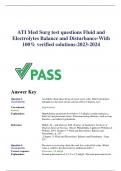Exam (elaborations)
ATI Med Surg test questions Fluid and Electrolytes Balance and Disturbance-With 100% verified solutions-
- Course
- Institution
ATI Med Surg test questions Fluid and Electrolytes Balance and Disturbance-With 100% verified solutions- Answer Key Question 1: (see full question) An elderly client takes 40 mg of Lasix twice a day. Which electrolyte imbalance is the most serious adverse effect of diuretic use? You selec...
[Show more]



